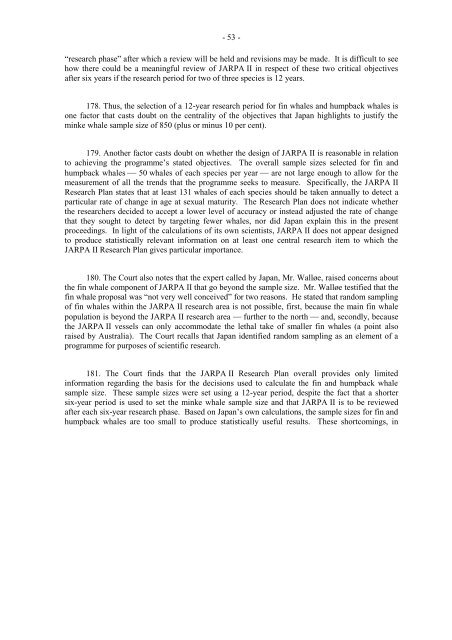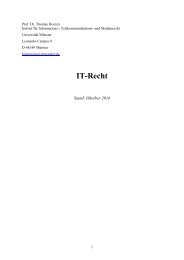3d4yVkKMl
3d4yVkKMl
3d4yVkKMl
Create successful ePaper yourself
Turn your PDF publications into a flip-book with our unique Google optimized e-Paper software.
- 53 -<br />
“research phase” after which a review will be held and revisions may be made. It is difficult to see<br />
how there could be a meaningful review of JARPA II in respect of these two critical objectives<br />
after six years if the research period for two of three species is 12 years.<br />
178. Thus, the selection of a 12-year research period for fin whales and humpback whales is<br />
one factor that casts doubt on the centrality of the objectives that Japan highlights to justify the<br />
minke whale sample size of 850 (plus or minus 10 per cent).<br />
179. Another factor casts doubt on whether the design of JARPA II is reasonable in relation<br />
to achieving the programme’s stated objectives. The overall sample sizes selected for fin and<br />
humpback whales 50 whales of each species per year are not large enough to allow for the<br />
measurement of all the trends that the programme seeks to measure. Specifically, the JARPA II<br />
Research Plan states that at least 131 whales of each species should be taken annually to detect a<br />
particular rate of change in age at sexual maturity. The Research Plan does not indicate whether<br />
the researchers decided to accept a lower level of accuracy or instead adjusted the rate of change<br />
that they sought to detect by targeting fewer whales, nor did Japan explain this in the present<br />
proceedings. In light of the calculations of its own scientists, JARPA II does not appear designed<br />
to produce statistically relevant information on at least one central research item to which the<br />
JARPA II Research Plan gives particular importance.<br />
180. The Court also notes that the expert called by Japan, Mr. Walløe, raised concerns about<br />
the fin whale component of JARPA II that go beyond the sample size. Mr. Walløe testified that the<br />
fin whale proposal was “not very well conceived” for two reasons. He stated that random sampling<br />
of fin whales within the JARPA II research area is not possible, first, because the main fin whale<br />
population is beyond the JARPA II research area further to the north and, secondly, because<br />
the JARPA II vessels can only accommodate the lethal take of smaller fin whales (a point also<br />
raised by Australia). The Court recalls that Japan identified random sampling as an element of a<br />
programme for purposes of scientific research.<br />
181. The Court finds that the JARPA II Research Plan overall provides only limited<br />
information regarding the basis for the decisions used to calculate the fin and humpback whale<br />
sample size. These sample sizes were set using a 12-year period, despite the fact that a shorter<br />
six-year period is used to set the minke whale sample size and that JARPA II is to be reviewed<br />
after each six-year research phase. Based on Japan’s own calculations, the sample sizes for fin and<br />
humpback whales are too small to produce statistically useful results. These shortcomings, in



